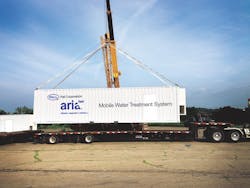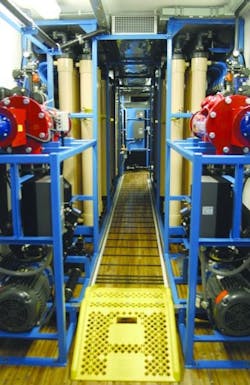About the author: Paul Clayton is industrial sales manager for Pall Water. Clayton can be reached at [email protected].
As water and wastewater regulations tighten, industrial facilities increasingly face wastewater and environmental discharge requirements that impact their water treatment needs. Due to this regulatory clamp down, facilities no longer can dispose of effluents, sludge and discharge in the same manner, forcing them to implement more robust methods of wastewater treatment.
Given the use of water to extract minerals, mines treat some of the most challenging wastewaters, and face some of the strictest regulations for environmental discharge to ensure water leaving mine sites does not contaminate downstream sources. To prevent pollution, groundwater and surface water quality is closely monitored, and mining facilities institute water management plans to meet regulatory standards prior to discharge. As such, mining facilities require the most robust and reliable wastewater treatment systems to ensure the safety and quality of the water that is returned to the environment.
While it is impossible to predict natural disasters that can lead to mine floods, adequate preparation can ensure that facilities are able to act quickly, efficiently and intelligently to minimize downtime and limit harmful discharge. As environmental discharge and facility runoff often contain pollutants and material detrimental to the natural environment, high quality, reliable water treatment is critical to minimize harm to the environment.
Limiting Harmful Pit Flood Discharge
Operations recently came to a halt at a remote Nevada mine following a 40 million gal pit flood resulting from groundwater recharge. An immediate solution was needed. The groundwater became contaminated with high concentrations of manganese (Mn), heavy metals and sulfides when introduced to the pit. As such, extensive wastewater treatment was required to meet the water quality regulations needed for agricultural irrigation.
After the flood, the mine immediately began evaluating multiple treatment alternatives and ultimately selected caustic neutralization combined with Pall Water’s mobile membrane filtration system to treat the 40 million gal of contaminated pit water. Caustic neutralization upstream of the mobile unit precipitated metals, and membranes removed high solids. A mobile membrane filtration system was selected for its speed of deployment and its ability to deliver high-quality water that meets the required limits for environmental discharge and reuse.
Within 30 days of the initial phone call to the mobile membrane provider, the mining customer was producing effluent. This short time period included water quality testing, system optimization and design, procurement, and system startup. In less than two months, the mobile membrane solution removed and treated all of the mine pit water allowing the barite mine operations to resume. Throughout the duration of the project, the system operated continuously and allowed monitoring of water quality to ensure compliance with downstream water treatment requirements. True to its initial goal, the treated pit water met environmental discharge limits and was used for irrigation in the local farming community adjacent to the mine site.
Given the critical speed of deployment, the mobile membrane unit’s fast response enabled the mine to remove the pit water in fewer than 60 days and safely discharge it while limiting harm to the environment.
Meeting Regulations
Requiring a faster, more affordable and reliable treatment solution than its existing media filtration unit, a gold mine in British Columbia, Canada, sought a filtration system capable of removing contaminants and protecting local waters.
The search intensified after a high water event and concerns of tailings storage flooding. To address these concerns, construction raised the tailings storage facility dam, which resulted in instability in the dam foundation. Temporary water storage for mine drainage was not available during construction and required a higher-capacity of water treatment for the anticipated high volume flows for freshet.
Ultimately, the mine selected a mobile membrane treatment system to replace its underperforming media filter and bring the mine one step closer to becoming operational, compliant and efficient. As the only reliable solution capable of meeting British Columbia’s strict environmental regulations, the membrane system was selected because it met discharge compliance standards, enabling the mine to properly release water into a nearby river.
In addition to removing the solids and particulate matter from the water, the membrane unit also could meet the limit demands of 0.5 mg/L arsenic during peak weeks of the spring freshet. On average, freshet water flow rates from mine workings are 13 L/s and increase to 20 L/s. With the mine’s maximum flow recordings nearly doubling that, Pall Water’s mobile unit had the best capabilities, reaching 35 L/s with no detriment to water quality at higher flow rates.
Following complete commissioning of the plant, the full mine drainage flow was treated and discharged for environmental compliance. The dual rack system resulted in no downtime even during commissioning or routine maintenance. Additionally, water quality of the discharge was maintained regardless of flow or inlet variables, and the arsenic removal targets also were achieved.
Water and wastewater treatment continue to be paramount as regulations mount due to ongoing water scarcity and environmental concerns. Once an afterthought for industrial plant managers, wastewater treatment is becoming an increasing priority and business imperative.

